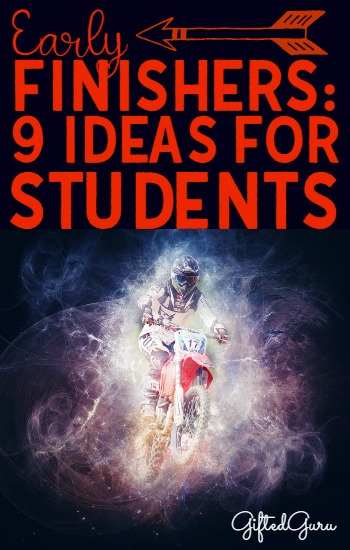Students who are early finishers can struggle with boredom, frustration, and staying, you know, nice.
This is because they sit and wait. Lather, rinse, repeat.
Last week I wrote about best practices for teachers with regard to early finishers, and today I’m focusing on the students (just in case their teachers didn’t read my ideas).
Here are 9 specific ideas for students who are early finishers.
The best defense is a good offense.
First, a couple of big ideas. Planning ahead is the main thing. Understand that gifted youth will often finish early, both on regular assignments and on tests. I wrote about why GT kids finish early on testing. It happens on regular assignments, too.
Because they know that already, they need to prepare and be prepared.
Parents can role play appropriate and inappropriate responses. Ask teachers what the teachers’ suggestions are. It won’t help to work with kids on things that won’t work in a classroom.
Go beyond the book.
Bringing a book (or ten) is most GT students’ default. Lunch? Check. Homework? Check. Twelve hundred page book in my backpack? Check.
This was my strategy. Can I tell you how hard it is to hide “Little Women” in your lap so your teacher can’t see it? #giftedkidproblems
Yet there are other strategies as well. Books work really well sometimes, and sometimes they work less well. For example, sometimes we’re so interested in what we’re reading that we are like caterpillars in a cocoon. We don’t hear anything. We don’t see anything. This can be a problem if the teacher wants to do something crazy like talk to us.
If you’re interested in some other ideas, read on for 9 of my favorite ideas for early finishers.
1. Zentangle
Zentangle® is an art form developed by Rick Roberts and Maria Thomas (who graciously allowed me to use their images for this handout).
In Zentangle, repetitive patterns fill defined spaces to form beautiful and complex designs that are deceptively simple to create. Just as important as the actual drawing is the feeling associated with it. Zentangling is relaxing, not stressful. There is no wrong – no “bad” Zentangling.
I love Zentangle because all you need is a pen and a piece of paper. It’s also silent. Because it’s not a verbal task, you can do it while you’re listening to people.
If you’re interested, you can check out the official Zentangle site, and visit Tangle Patterns, where you will find a million (or so) different patterns, step-by-step.
You can also watch this video for beginners to get a taste for it.
2. Labyrinth
A labyrinth is a complicated network of paths that lead the person walking them on a journey. Probably the most famous one is in France at the Cathedral at Chartres.
There is a saying that the object of a maze is to find its center, and the object of a labyrinth is to find your center.
A labyrinth is normally walked, but there are also finger labyrinths. These finger labyrinths are a great strategy for dealing with down time because all you need is the piece of paper (you can even make one smaller than a whole piece of paper).
They are also silent, and they don’t disturb anyone else. Like Zentangle, they aren’t a verbal task, so you can use them when you’re listening.
I’ve got a couple that you can print out.
You can learn how to draw a labyrinth yourself by watching this video.
3. Memorizing Something
When you have something in your head, you are never at the mercy of whatever is going on around you.
I’ve written about why I think you should memorize poetry. There are even more things to memorize that you can then run through in your mind and no one will ever know. It will be our little secret.
Here are some ideas besides poetry:
- the periodic table of the elements
- countries of the world (and their capitals)
- states in the United States (and their capitals)
- bones in the body
- presidents of the United States
- famous speeches like the Gettysburg Address or John F. Kennedy’s Inaugural Speech or Martin Luther King’s I Have a Dream.
- cool stuff from Shakespeare like Hamlet’s soliloquoy
- oceans and seas of the world
- constellations
4. Tiny Exercise
It can help to move a little bit, so you look at ideas for exercises you can do at your desk, and decide which ones you could do without anyone noticing (think teensy tiny micro exercises).
5. Mental Math
Count by 5s or 10s or do the digits of pi. You can make it a little harder by multiplying fractions or other tricksty stuff.
You can learn some mental math tricks and practice those.
6. Mindfulness
Learning how to be fully present in the moment without judging the moment is called mindfulness. You can find out more about mindfulness on the Emotional Health page.
If you practice this, you will find that you will be less bothered by a few minutes of waiting here and there. It takes practice, though, so don’t send me an email telling me you tried it once but it didn’t work.
7. Play, “What do I notice?”
Look around and see what colors can you see? Get really specific. How many ceiling tiles are there?
How many students are in the room have brown hair? How many bulletin boards are there? What else do you see? This is like your own “eye spy” game.
8. Counting un, deux, trois…
Learn how to count in other languages.
Try:
9. Positive Outlook
Admit it: a big part of not going crazy is attitude. People who feel in control of their own lives (it’s called “internal locus of control“) are more motivated and overall happier.
If you will accept that you are in control of your own life, and that how you act when you are in a waiting situation is also within your control, you will be happier, less frustrated, and generally better off.
You may also like the teacher version of how to handle fast finishers. There are even more ideas!
I hope these ideas have helped. If you try them, please let me know!






